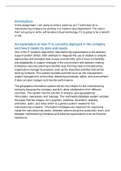Other
Unit 16 Cloud Storage and Collaboration tools LAA
- Institution
- PEARSON (PEARSON)
This assignment is for Unit 16 Cloud Storage and Collaboration tools LAA guarantees distinction as it is improved. You can find a bundle for unit 16 which is discounted.
[Show more]



